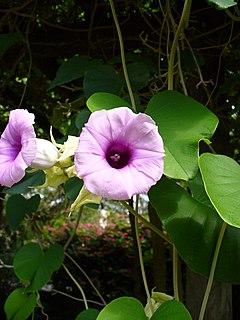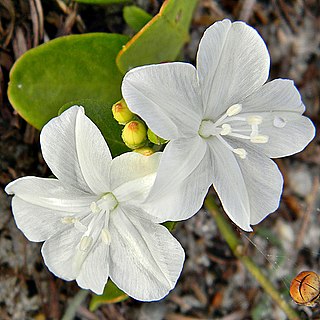
Convolvulaceae, known commonly as the bindweed or morning glory family, is a family of about 60 genera and more than 1,650 species of mostly herbaceous vines, but also trees, shrubs and herbs, and also including the sweet potato and a few other food tubers.

Argyreia is a genus of plants in the family Convolvulaceae.

Myrica is a genus of about 35–50 species of small trees and shrubs in the family Myricaceae, order Fagales. The genus has a wide distribution, including Africa, Asia, Europe, North America and South America, and missing only from Australia. Some botanists split the genus into two genera on the basis of the catkin and fruit structure, restricting Myrica to a few species, and treating the others in Morella.

Archidendron is a genus of flowering plants in the pea family, Fabaceae.

Bonamia is a genus of the flowering plant family Convolvulaceae, commonly known as the bindweed family and named after the French physician and botanist François Bonamy (1710-1786). Members of the genus are commonly known as the lady's nightcap.

Maytenus is a genus of flowering plants in the family Celastraceae. Members of the genus are distributed throughout Central and South America, Southeast Asia, Micronesia and Australasia, the Indian Ocean and Africa. They grow in a very wide variety of climates, from tropical to subpolar. In 2017, a taxonomic review moved 123 species of Maytenus to a new genus, called Monteverdia.

Scleropyrum is a genus of trees in family Santalaceae first described as a genus in 1838. At present, only one species is recognized, although several others are listed as "unresolved," meaning that further research is needed to determine affinities.

Seddera is a genus of plants in the bindweed family Convolvulaceae.

Ehretia is a genus of flowering plants in the borage family, Boraginaceae. It contains about 50 species. The generic name honors German botanical illustrator Georg Dionysius Ehret (1708–1770).

Operculina is a genus of plants in the morning-glory family which that are found throughout the world.

Jacquemontia is a genus of plants in the morning glory family Convolvulaceae. Species in this genus are commonly known as clustervine.

Erycibe is a genus of plants in the family Convolvulaceae, found in the Andaman Islands, Sri Lanka, India including Assam, Bangladesh, Myanmar, east Himalaya, southern and southeastern China including Hainan and Taiwan, Southeast Asia, Malesia, Papuasia, Australia, and Japan including the Ryukyu Islands.
Astripomoea is a genus of flowering plants belonging to the family Convolvulaceae.
Calycobolus is a genus of flowering plants belonging to the family Convolvulaceae.
Distimake is a genus of flowering plants belonging to the family Convolvulaceae.















